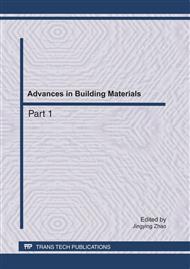[1]
Hans W. Reinhardt, concrete materials: high-tech and sustainable, The 4rd International Forum on Advances in Structural Engineering, chapter 3, China Architecture & Building Press (2010).
Google Scholar
[2]
Dai jianguo, Song yupu, Zhao guofan, Mechanical significance of low elastic modulus fiberreinforced concrete flexural strength. China concrete and cement products, 1999, 2(1):35~38
Google Scholar
[3]
Yi cheng, Pang zhiyu, Dai chengqin, Energy consumption mechanisms of steel fiber, synthetic fiber and their influence on mechanical properties of fiber concrete. Journal of Harbin University of C.E. & Architecture, 1998, 31(6):88~93
Google Scholar
[4]
Zhang lihe, Tan muhua, Ma yipin, Wu keru, Study on interface bonding of PP fiber-cementand anti-shrinkage performance. Journal of building materials, 2001, 4(1):17~21
Google Scholar
[5]
Qian chunxiang, Geng fei, Li li, Mechanism research on improvement of resistance to plastic shrinkage and cracking of cement mortar by polypropylene fibers. Journal of southeast university, 2005, 35(5): 786~791
Google Scholar
[6]
Zhang Yi. Mechanics of chloride ions transportion in concrete . Zhejiang university,2008.
Google Scholar
[7]
Pigeon M and R. Pleau, Durability of Concrete in Cold Climates, E&FN Spon, London,(1995)
Google Scholar
[8]
Rosli. A and Harnick, Improving the durability of concrete to freezing and deicing salts. Durability of Building Materials and Components, (1980)
DOI: 10.1520/stp36081s
Google Scholar
[9]
Kejin wang, Surendra P.Shah and Pariya Phuaksuk, Plastic shrinkage Cracking in Concrete Materials-Influence of Fly Ash and Fibers. ACI Materials Journal, 2001, 98(6):455-464.
DOI: 10.14359/10846
Google Scholar
[10]
MASO J C. The bond between aggregates and hydrated cement paste. In: Proceeding of 7th International Congress on the Chemistry of Cement. Vol 3, Paris: Septima, 1980, V II-1/3- V II-1/15.
Google Scholar


